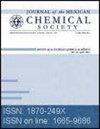Chemical Characterization and Antioxidant Evaluation of Young and Aged Wines from Aguascalientes and Queretaro
IF 0.8
4区 化学
Q3 CHEMISTRY, MULTIDISCIPLINARY
引用次数: 1
Abstract
Abstract. Red wine is distinguished by a high economic and cultural value and therefore, its reliable characterization is important to assess its quality and authentication. Currently, Mexican wine consumption is growing due to wine tourism initiatives, then the determination of the chemical profile of commercial selected samples of young and aged red wines produced at wineries from Queretaro and Aguascalientes was performed. Seventy-eight nonvolatile compounds were identified by ultra performance liquid chromatography coupled to mass spectrometry. Three main families of secondary metabolites (Flavonols, ellagitannins and anthocyanins) were quantified by differential pulse voltammetry using carbon screen printed electrodes (SPEs). Tempranillo aged wine from Vinos del Marqués, Queretaro, showed the highest content of total polyphenols and anthocyanins from the evaluated wine samples. This research contributes to the knowledge of the chemical profile of commercial selected samples from wineries that belong to Mexican wine routes in a consolidated and experimental stage. Resumen. El vino tinto se distingue por un alto valor económico y cultural y, por lo tanto, su caracterización confiable es importante para evaluar su calidad y autenticación. Actualmente, el consumo de vinos mexicanos se encuentra en crecimiento debido a las iniciativas de enoturismo, por ello, se llevó a cabo la determinación del perfil químico de muestras comerciales seleccionadas de vinos tintos jóvenes y de conserva producidos en bodegas de Querétaro y Aguascalientes. Se identificaron setenta y ocho compuestos no volátiles mediante cromatografía líquida de alta resolución acoplada a espectrometría de masas. Tres familias principales de metabolitos secundarios (flavonoles, elagitaninos y antocianinas) fueron cuantificadas mediante voltamperometría de pulso diferencial utilizando electrodos serigrafiados (SPEs) de carbón. El vino Tempranillo conserva de Vinos del Marqués, Querétaro, mostró el mayor contenido de polifenoles totales y antocianinas de las muestras de vino evaluadas. Esta investigación contribuye al conocimiento del perfil químico de muestras comerciales seleccionadas de bodegas pertenecientes a las rutas del vino mexicano en etapa consolidada y experimental.阿瓜斯卡连特斯和克雷塔罗年轻和陈年葡萄酒的化学特性及抗氧化评价
摘要红葡萄酒具有很高的经济和文化价值,因此,其可靠的特性对评估其质量和认证非常重要。目前,由于葡萄酒旅游计划,墨西哥葡萄酒消费量正在增长,然后对克雷塔罗和阿瓜斯卡莲特斯酿酒厂生产的年轻和陈年红葡萄酒的商业精选样品的化学成分进行了测定。采用超高效液相色谱-质谱联用技术鉴定了78种非挥发性化合物。采用碳丝网印刷电极(SPEs)差分脉冲伏安法对黄酮醇、鞣花单宁和花青素三个主要次生代谢产物进行了定量分析。来自克雷塔罗州马奎梅斯酒庄的丹尼罗陈年酒显示出在评估的葡萄酒样品中总多酚和花青素的含量最高。这项研究有助于在一个巩固和实验阶段从属于墨西哥葡萄酒路线的葡萄酒厂的商业选择样品的化学概况的知识。Resumen。埃尔维诺将独特的穷人视为英雄económico通过文化,穷人视为英雄,例如caracterización可以通过autenticación作为重要的评估标准。实际上,墨西哥葡萄酒的消费者在墨西哥葡萄酒的消费和葡萄酒的消费和葡萄酒的消费方面,在墨西哥葡萄酒的消费和葡萄酒的消费方面,在墨西哥葡萄酒的消费方面,在墨西哥葡萄酒的消费方面,在墨西哥葡萄酒的消费方面,在墨西哥葡萄酒的消费方面,在墨西哥葡萄酒的消费方面,在墨西哥葡萄酒的消费方面,在墨西哥葡萄酒的消费方面,在墨西哥葡萄酒的消费方面,在墨西哥葡萄酒的消费方面,在墨西哥葡萄酒的消费方面,在墨西哥葡萄酒的消费方面,在墨西哥葡萄酒的消费方面,在墨西哥葡萄酒的消费方面,在墨西哥葡萄酒的消费方面,在墨西哥葡萄酒的消费方面,在墨西哥葡萄酒的消费方面,在墨西哥葡萄酒的消费方面。通过ocho compuestos no volátiles mediante cromatografía líquida de alta resolución acoplada a espectrometría de masas进行识别。非常项目螯de metabolitos secundarios(黄酮醇,elagitaninos y antocianinas) fueron cuantificadas mediante voltamperometria de一些diferencial使用electrodos serigrafiados (spe) de碳。El vino Tempranillo conserva de Vinos del marquemacry, queremacry, mostró El mayor conidedo de polifenoles,通过对marcustras de vino evaluadas的数据进行分析。Esta investigación contribuciciiento del perfil químico de muestras商业选择,de bodedegas perciente, as rutas del vinino mexicano, en eta consolidation with experimental。
本文章由计算机程序翻译,如有差异,请以英文原文为准。
求助全文
约1分钟内获得全文
求助全文
来源期刊
CiteScore
2.00
自引率
0.00%
发文量
0
审稿时长
6-12 weeks
期刊介绍:
The Journal of the Mexican Chemical Society (J. Mex. Chem. Soc.) is a scientific, blind, peer reviewed, and open access, free of charge publication that covers all areas of chemistry and its sub-disciplines (i.e. medicinal chemistry, natural products, electrochemistry, material science, computational chemistry, organic chemistry, bionirganic chemistry, etc). It is devoted to facilitating the worldwide advancement of our understanding of chemistry. It will primarily publish original contributions of research in all branches of the theory and practice of chemistry in its broadest context as well as critical reviews in active areas of chemical research where the author has published significant contribution. The J. Mex. Chem. Soc. is a quarterly publication which language of submission and publication is English. To be suitable for publication in J. Mex. Chem. Soc., manuscripts must describe novel aspects of chemistry, high quality of results and discussion an excellent bibliographic support, and contribute to the development of the field. Routine or incremental work are not suitable for publication in J. Mex. Chem. Soc. Authors are encouraged to send contributions in electronic form. Our online submission system guides you stepwise through the process of entering your article details and uploading your files.

 求助内容:
求助内容: 应助结果提醒方式:
应助结果提醒方式:


